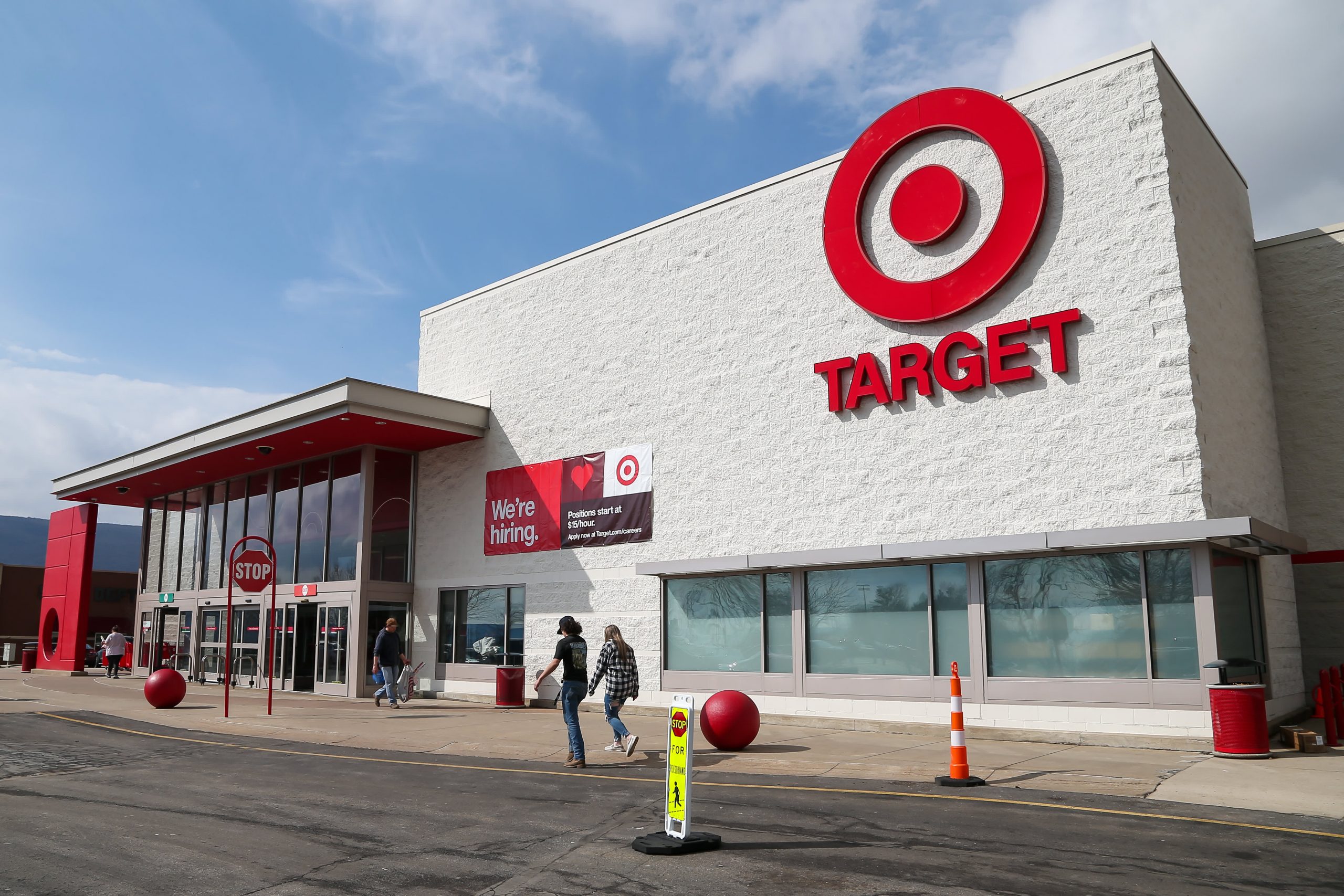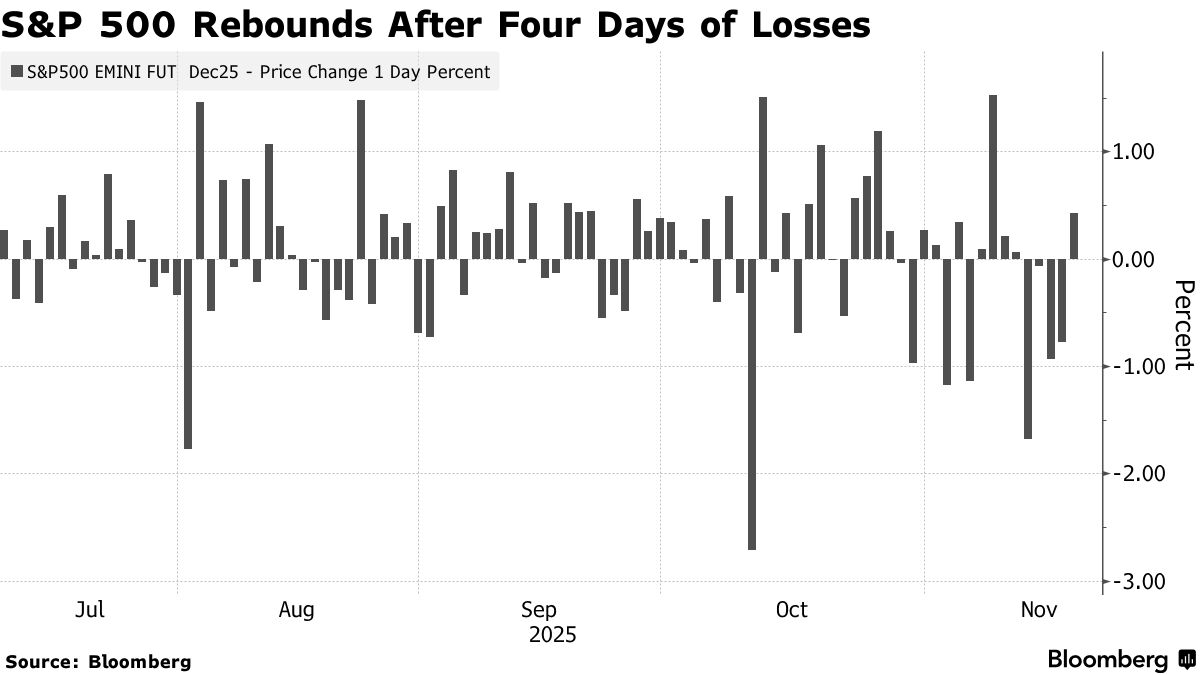—— Target Cuts Full-Year Profit Outlook as Turnaround Proves Slower; US Trade Deficit Narrowed in August; US Stocks’ Longest Slide Since August Is a Dip-Buying Chance, JPMorgan Says; BLS Will Skip October Jobs Report; Many Fed Officials Favored Holding Rates Steady Through 2025; Meta AI Chief Yann LeCun to Leave Company and Launch New Startup; Nvidia Delivers Strong Forecast, Easing Fears of an AI Spending Crash
1. Target Cuts Full-Year Profit Outlook as Turnaround Proves Slower
Target Corp. trimmed its profit forecast for the year, signaling that its turnaround is taking longer than expected as the retailer grapples with markdowns and weak demand in key merchandise categories.
The company now expects adjusted earnings per share of $7 to $8 this year, lowering the top end of its prior range. Third-quarter profit exceeded analyst estimates, but comparable sales fell more than expected. “We are relentless in our pursuit of returning to growth and not satisfied with our current results,” said Chief Operating Officer Michael Fiddelke, who becomes CEO in February.
The retailer continues to struggle to regain momentum following its pandemic boom. A cooling job market, inflation, and consumer boycotts tied to diversity initiatives have weighed on performance.
Fiddelke said the quarter showed “choppiness” across the business and that the company is adjusting its guidance accordingly. Target will boost capital spending by 25% to $5 billion next year to remodel stores, open new locations and improve merchandise and the shopping experience.
Shares fell 3% in pre-market trading. Target stock is down nearly 35% this year through Tuesday’s close, compared with a roughly 13% gain in the S&P 500 Index.

Bloomberg – Target Lowers Top End of Profit Outlook on Soft Demand
______
2. US Trade Deficit Narrowed in August
The US trade deficit shrank sharply in August as a wave of global tariffs from President Donald Trump kicked in, according to Commerce Department data released Wednesday after a delay caused by the government shutdown.
The goods and services deficit narrowed almost 24% from July to $59.6 billion, beating economists’ expectations of $60.4 billion. The report had been scheduled for Oct. 7 but was postponed due to the record shutdown. A new release date for the September report has not yet been set.
Imports fell 5.1%, the most in four months, while exports edged higher. The figures are not adjusted for inflation.
A month earlier, the deficit had widened as companies rushed to import goods ahead of the so-called reciprocal tariffs. Those duties, announced in April and paused for several months during negotiations, ultimately went into effect in August.
The sharp monthly swings in trade have contributed to volatility in GDP figures. Before the August release, the Atlanta Fed’s GDPNow model estimated that net exports would add 0.57 percentage point to third-quarter GDP.

______
Bloomberg – US Trade Deficit Narrowed in August After Tariffs Set In
______
3. US Stocks’ Longest Slide Since August Is a Dip-Buying Chance, JPMorgan Says
US stocks have posted their longest decline since August, but JPMorgan Chase & Co.’s trading desk says the selloff has created a buying opportunity.
Concerns ranging from the durability of the artificial-intelligence trade to the Federal Reserve’s policy trajectory triggered a four-day drop that erased 3.4% from the S&P 500 Index through Tuesday’s close. Andrew Tyler, head of global market intelligence at JPMorgan, called the decline a “technical washout” that may already have ended.
“Given that there have not been any changes to the fundamental story, nor does our investment hypothesis rely on the Fed easing, we are dip-buyers,” Tyler wrote in a Wednesday note.
Stocks rebounded Wednesday morning as traders awaited earnings from Nvidia Corp., the AI bellwether, and the September nonfarm payrolls report later this week. Tyler said the two events “could set the stage for the next run to or through all-time highs.”
Despite still-rich valuations, the selloff pushed the S&P 500’s 12-month forward price-to-earnings ratio down to 21.9 — the lowest since August. A Deutsche Bank gauge also showed equity positioning slipping back to neutral last week, with discretionary investors turning underweight, suggesting near-term buying capacity.
Still, stretched positioning and elevated valuations have drawn warnings. Goldman Sachs President John Waldron said Wednesday that markets could see more losses. The founder of Algebris Investments urged investors to trim exposure to mega-cap tech, making a bearish case for AI. The S&P 500 is down 3% this month, on track for its worst November since 2008, amid skepticism over whether AI can deliver enough revenue and profit to justify massive infrastructure spending.

Bloomberg – JPMorgan Trading Desk Says Buy the Dip in Stocks
______
4. BLS Will Skip October Jobs Report
The Bureau of Labor Statistics said it will not publish an October employment report, instead incorporating that month’s payroll figures into the November report set for release on Dec. 16.
The agency said that October household data — which informs statistics such as the unemployment rate — could not be collected retroactively. As a result, the unemployment rate and other household-survey metrics for October will be absent. To compensate, BLS is extending the collection periods for both the household and establishment surveys for November.
The jobs report consists of two main surveys: the household survey and the establishment survey, which produces the payrolls figure. While businesses typically maintain records and can report payroll data electronically, reaching individual workers by phone to ask about their employment status for a specific week in October is not feasible after the fact.
The cancellation adds uncertainty for the Federal Reserve ahead of its final policy meeting of the year. Following the announcement, investors saw lower odds of a December rate cut, expecting Fed officials to remain divided without fresh labor-market data.
BLS is also foregoing the September Job Openings and Labor Turnover Survey (JOLTS), and will release both September and October data on Dec. 9 — the same day the Fed begins its two-day meeting. The agency has yet to announce whether the October consumer price index will be released.

Bloomberg – BLS Cancels October Jobs Report, Couldn’t Collect Some Data
______
5. Many Fed Officials Favored Holding Rates Steady Through 2025
Many Federal Reserve policymakers said it would likely be appropriate to keep interest rates unchanged for the rest of 2025, according to minutes from the Federal Open Market Committee’s Oct. 28–29 meeting.
The record also showed that several officials opposed lowering the benchmark rate at that gathering.
Still, multiple participants said that another rate cut in December “could well be appropriate” if the economy evolves in line with their expectations before the next meeting — underscoring growing uncertainty over whether inflation or unemployment poses the greater risk.
A majority of voting members agreed to lower rates by a quarter point for the second straight meeting, though two officials dissented:
— Governor Stephen Miran, Trump’s recent appointee, favored a half-point cut.
— Kansas City Fed President Jeff Schmid preferred to hold rates steady.
At the press conference, Chair Jerome Powell surprised markets by stressing that a December cut was “not a foregone conclusion.”
Futures markets now imply about a 30% chance of a December rate cut.
Since then, Fed officials more focused on inflation have dominated public remarks, pushing investors to scale back expectations.

Bloomberg – Fed Minutes Show ‘Many’ Officials Lean Against December Cut
______
6. Meta AI Chief Yann LeCun to Leave Company and Launch New Startup
Yann LeCun — an AI pioneer and head of Meta’s AI research lab — plans to leave the company and start a new venture, according to people familiar with the matter.
LeCun, who joined Meta in 2013, is expected to announce his departure as early as this week. Meta plans to partner with his new startup, though details remain under discussion, one person said.
His forthcoming company will focus on his vision for Joint Embedding Predictive Architecture (JEPA) world models — systems trained on visual and sensory data to better predict the physical world. A Meta spokesperson confirmed LeCun is leaving. LeCun did not immediately respond to a request for comment.
LeCun, widely regarded as one of AI’s “godfathers,” has led Meta’s long-term AI research, much of which may not impact consumer products for many years. As Meta shifted resources toward near-term competitive models to counter OpenAI, Google and Anthropic, LeCun found it increasingly difficult to secure internal support.
He has been publicly critical of the industry’s fixation on large language models (LLMs), arguing that LLMs aren’t the path to human-level intelligence — a stance that clashed with Meta’s Llama strategy and its broader pivot toward “superintelligence.” His outspoken views created internal friction, sources said.
When Meta built a new AI lab this summer, spending billions on AI talent, it hired external leadership instead of elevating LeCun. After the underwhelming reception of Llama 4, and Meta’s strategic shift, some employees pushed to reduce LeCun’s public visibility, worrying he wouldn’t stay aligned with the company’s pro-LLM messaging.
His support for open-source AI also conflicts with Meta’s recent move away from openness.

Bloomberg – Meta AI’s LeCun to Announce Exit, Startup as Soon as This Week
______
7. Nvidia Delivers Strong Forecast, Easing Fears of an AI Spending Crash
Paramount Skydance Corp. is working with a consortium of Middle Eastern sovereign wealth funds on a $71 billion offer for Warner Bros. Discovery Inc., Variety reported, citing people familiar with the talks.
The group includes Saudi Arabia’s Public Investment Fund, the Qatar Investment Authority and the Abu Dhabi Investment Authority, with RedBird Capital also backing the effort. The offer values Warner Bros. Discovery at about $28.65 per share and is reportedly being largely financed by the Ellison family. Each sovereign fund would contribute $7 billion, while Paramount Skydance would provide about $50 billion.
Warner Bros.’s board has already rejected previous offers from Paramount of up to $23.50 a share, Bloomberg has reported. The company has formally put itself up for sale, with a Thursday deadline for bids. In addition to Paramount, Netflix Inc. and Comcast Corp. are expected to bid for select assets such as the film and streaming division.
Paramount remains the only party seeking to buy the entire company.

Bloomberg – Nvidia Shares Climb After Sales Outlook Trounces Estimates
______